2023 HYUNDAI IONIQ 6 warning
[x] Cancel search: warningPage 468 of 582

Driver Assistance System
7-124
Parking Collision-Avoidance Assist
disabled
B7008102
B7008103
The ‘Parking Collision-Avoidance Assist
system limited. Camera obscured’ or
‘Parking Collision-Avoidance Assist syst.
limited. Ultrasonic sensor blocked’
warning message will appear on the
instrument cluster if the following
situations occur:
• The camera(s) or ultrasonic sensor(s) is covered with foreign material, such as
snow or rain, etc.
• There is inclement weather, such as heavy snow, heavy rain, etc.
If this occurs, Parking
Collision-Avoidance Assist may turn off or
may not operate properly. Check whether
the cameras and ultrasonic sensors are
clean.
Limitations of Parking
Collision-Avoidance Assist
Parking Collision-Avoidance Assist may
not assist braking or warn the driver even
if there are pedestrians or objects under
the following circumstances:
• Problems with vehicle - Any non-factory equipment or accessory is installed
- Your vehicle is unstable due to an accident or other causes
- Bumper height or rear ultrasonic sensor installation has been modified
- Wide view camera(s) or ultrasonic sensor(s) is damaged
- Wide view camera(s) or the ultrasonic sensor(s) is stained with
foreign material, such as snow, dirt,
etc.
- Wide view camera(s) is obscured by a light source or by inclement weather,
such as heavy rain, fog, snow, etc.
- Your vehicle height is low or high due to heavy loads, abnormal tire
pressure, etc.
• Problems with the surroundings - The surrounding is very bright or very dark
- Outside temperature is very high or very low
- The wind is either strong (above 12 mph (20 km/h)) or blowing
perpendicular to the rear bumper
- Objects generating excessive noise, such as vehicle horns, loud
motorcycle vehicles or truck air
brakes, are near your vehicle
- An ultrasonic sensor with similar frequency is near your vehicle
- The road is slippery or inclined
- The image of the pedestrian in the front view camera is
indistinguishable from the
background
• Problems with pedestrian or object
Hyundai_CE_en_US.book Page 124
Page 469 of 582
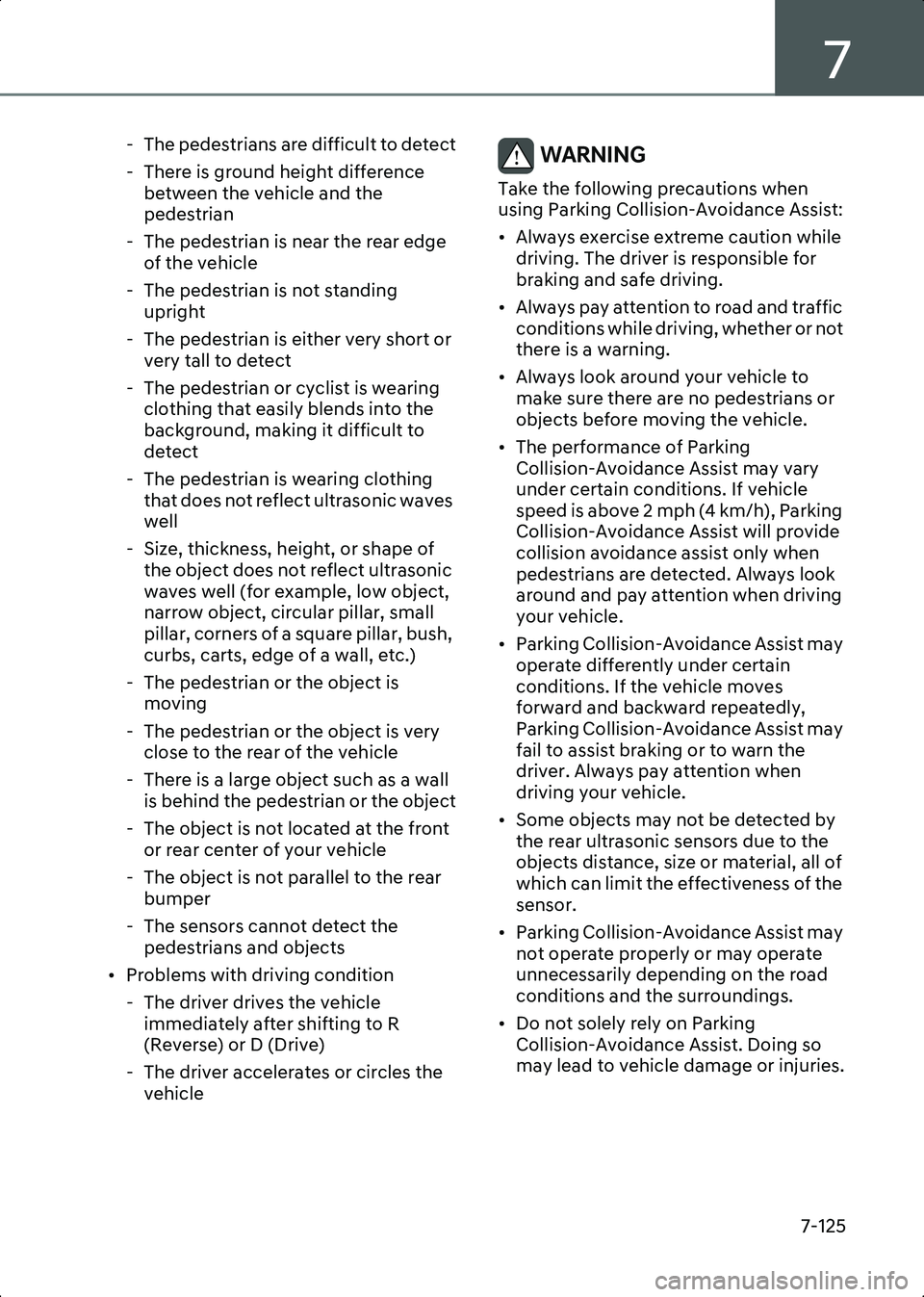
7
7-125
- The pedestrians are difficult to detect
- There is ground height difference between the vehicle and the
pedestrian
- The pedestrian is near the rear edge of the vehicle
- The pedestrian is not standing upright
- The pedestrian is either very short or very tall to detect
- The pedestrian or cyclist is wearing clothing that easily blends into the
background, making it difficult to
detect
- The pedestrian is wearing clothing that does not reflect ultrasonic waves
well
- Size, thickness, height, or shape of the object does not reflect ultrasonic
waves well (for example, low object,
narrow object, circular pillar, small
pillar, corners of a square pillar, bush,
curbs, carts, edge of a wall, etc.)
- The pedestrian or the object is moving
- The pedestrian or the object is very close to the rear of the vehicle
- There is a large object such as a wall is behind the pedestrian or the object
- The object is not located at the front or rear center of your vehicle
- The object is not parallel to the rear bumper
- The sensors cannot detect the pedestrians and objects
• Problems with driving condition - The driver drives the vehicle immediately after shifting to R
(Reverse) or D (Drive)
- The driver accelerates or circles the vehicleWARNING Take the following precautions when
using Parking Collision-Avoidance Assist:
• Always exercise extreme caution while driving. The driver is responsible for
braking and safe driving.
• Always pay attention to road and traffic conditions while driving, whether or not
there is a warning.
• Always look around your vehicle to make sure there are no pedestrians or
objects before moving the vehicle.
• The performance of Parking Collision-Avoidance Assist may vary
under certain conditions. If vehicle
speed is above 2 mph (4 km/h), Parking
Collision-Avoidance Assist will provide
collision avoidance assist only when
pedestrians are detected. Always look
around and pay attention when driving
your vehicle.
• Parking Collision-Avoidance Assist may operate differently under certain
conditions. If the vehicle moves
forward and backward repeatedly,
Parking Collision-Avoidance Assist may
fail to assist braking or to warn the
driver. Always pay attention when
driving your vehicle.
• Some objects may not be detected by the rear ultrasonic sensors due to the
objects distance, size or material, all of
which can limit the effectiveness of the
sensor.
• Parking Collision-Avoidance Assist may not operate properly or may operate
unnecessarily depending on the road
conditions and the surroundings.
• Do not solely rely on Parking Collision-Avoidance Assist. Doing so
may lead to vehicle damage or injuries.
Hyundai_CE_en_US.book Page 125
Page 470 of 582
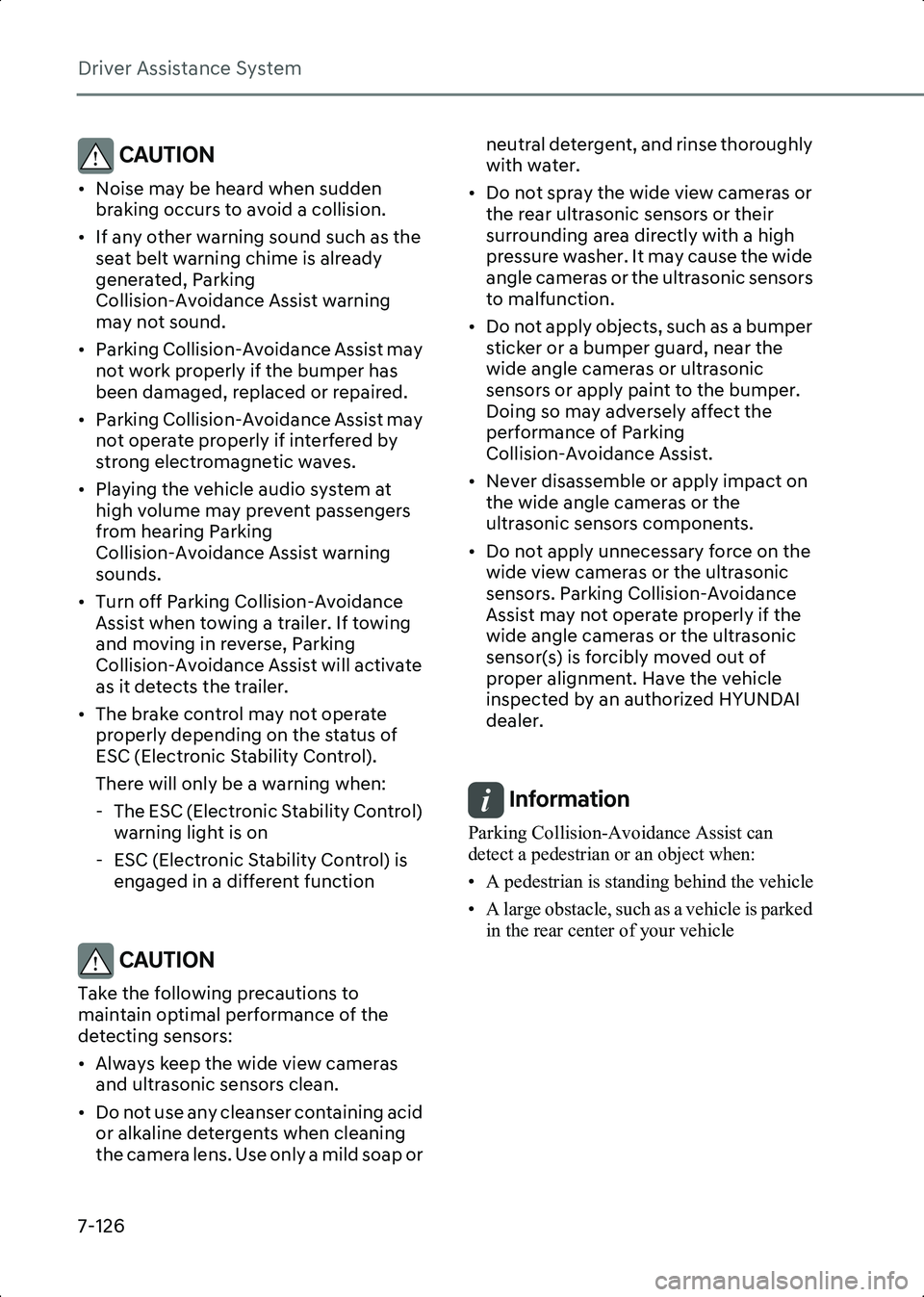
Driver Assistance System
7-126
CAUTION • Noise may be heard when sudden braking occurs to avoid a collision.
• If any other warning sound such as the seat belt warning chime is already
generated, Parking
Collision-Avoidance Assist warning
may not sound.
• Parking Collision-Avoidance Assist may not work properly if the bumper has
been damaged, replaced or repaired.
• Parking Collision-Avoidance Assist may not operate properly if interfered by
strong electromagnetic waves.
• Playing the vehicle audio system at high volume may prevent passengers
from hearing Parking
Collision-Avoidance Assist warning
sounds.
• Turn off Parking Collision-Avoidance Assist when towing a trailer. If towing
and moving in reverse, Parking
Collision-Avoidance Assist will activate
as it detects the trailer.
• The brake control may not operate properly depending on the status of
ESC (Electronic Stability Control).
There will only be a warning when:
- The ESC (Electronic Stability Control) warning light is on
- ESC (Electronic Stability Control) is engaged in a different function
CAUTION Take the following precautions to
maintain optimal performance of the
detecting sensors:
• Always keep the wide view cameras and ultrasonic sensors clean.
• Do not use any cleanser containing acid or alkaline detergents when cleaning
the camera lens. Use only a mild soap or neutral detergent, and rinse thoroughly
with water.
• Do not spray the wide view cameras or the rear ultrasonic sensors or their
surrounding area directly with a high
pressure washer. It may cause the wide
angle cameras or the ultrasonic sensors
to malfunction.
• Do not apply objects, such as a bumper sticker or a bumper guard, near the
wide angle cameras or ultrasonic
sensors or apply paint to the bumper.
Doing so may adversely affect the
performance of Parking
Collision-Avoidance Assist.
• Never disassemble or apply impact on the wide angle cameras or the
ultrasonic sensors components.
• Do not apply unnecessary force on the wide view cameras or the ultrasonic
sensors. Parking Collision-Avoidance
Assist may not operate properly if the
wide angle cameras or the ultrasonic
sensor(s) is forcibly moved out of
proper alignment. Have the vehicle
inspected by an authorized HYUNDAI
dealer.
Information Parking Collision-Avoidance Assist can
detect a pedestrian or an object when:
• A pedestrian is standing behind the vehicle
• A large obstacle, such as a vehicle is parked in the rear center of your vehicle
Hyundai_CE_en_US.book Page 126
Page 471 of 582
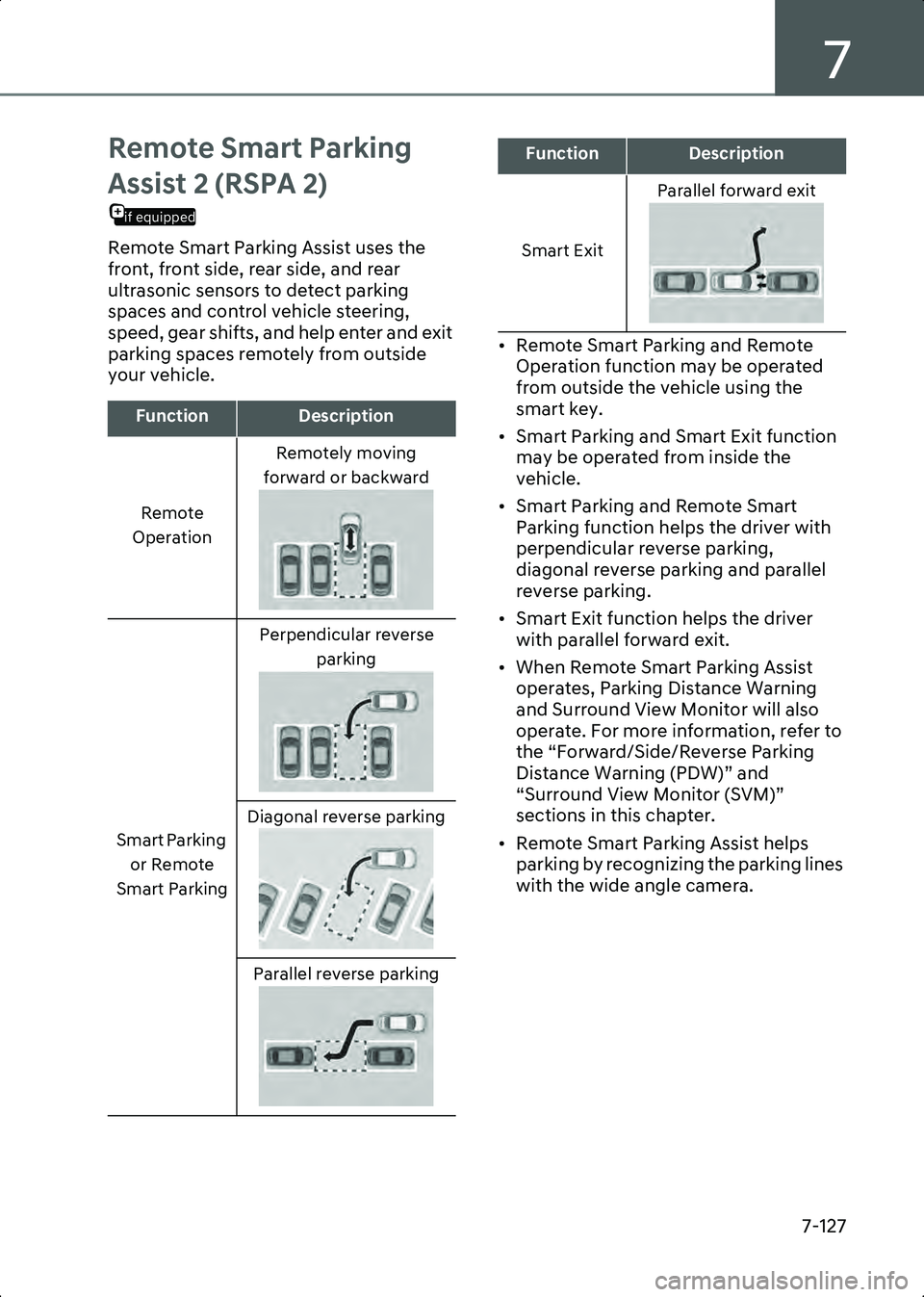
7
7-127
Remote Smart Parking
if equipped
Assist 2 (RSPA 2)
Remote Smart Parking Assist uses the
front, front side, rear side, and rear
ultrasonic sensors to detect parking
spaces and control vehicle steering,
speed, gear shifts, and help enter and exit
parking spaces remotely from outside
your vehicle.• Remote Smart Parking and Remote
Operation function may be operated
from outside the vehicle using the
smart key.
• Smart Parking and Smart Exit function may be operated from inside the
vehicle.
• Smart Parking and Remote Smart Parking function helps the driver with
perpendicular reverse parking,
diagonal reverse parking and parallel
reverse parking.
• Smart Exit function helps the driver with parallel forward exit.
• When Remote Smart Parking Assist operates, Parking Distance Warning
and Surround View Monitor will also
operate. For more information, refer to
the “Forward/Side/Reverse Parking
Distance Warning (PDW)” and
“Surround View Monitor (SVM)”
sections in this chapter.
• Remote Smart Parking Assist helps parking by recognizing the parking lines
with the wide angle camera.
FunctionDescription
Remote
Operation Remotely moving
forward or backward
Smart Parking or Remote
Smart Parking Perpendicular reverse
parking
Diagonal reverse parking Parallel reverse parking
Smart Exit Parallel forward exit
FunctionDescription
Hyundai_CE_en_US.book Page 127
Page 473 of 582

7
7-129
camera performance and Remote
Smart Parking Assist may not operate
properly.
• Do not manually adjust the side view mirror or use Remote Smart Parking
Assist after a hard impact on the side
view mirror. When a collision occurs or
the side view mirror is manually
operated, Remote Smart Parking Assist
may not operate properly.
Remote Smart Parking Assist
Settings
Warning Methods
B7002602
With the vehicle on, go to Setup > Vehicle
> Driver Assistance > Warning Methods
from the Settings in the infotainment
system to select the following:
• Warning Volume : The Warning Volume
can be adjusted.
Information • If you change the Warning Methods, Warning Methods of other Driver
Assistance systems may change.
• If the vehicle is restarted, Warning Methods will maintain the last setting.
• There may be no Settings menu depending on the feature applied to your vehicle.
• Even though 0 is selected for Warning
Volume, Warning Volume will not be
turned off but Warning Volume will sound
as 1.
Hyundai_CE_en_US.book Page 129
Page 474 of 582
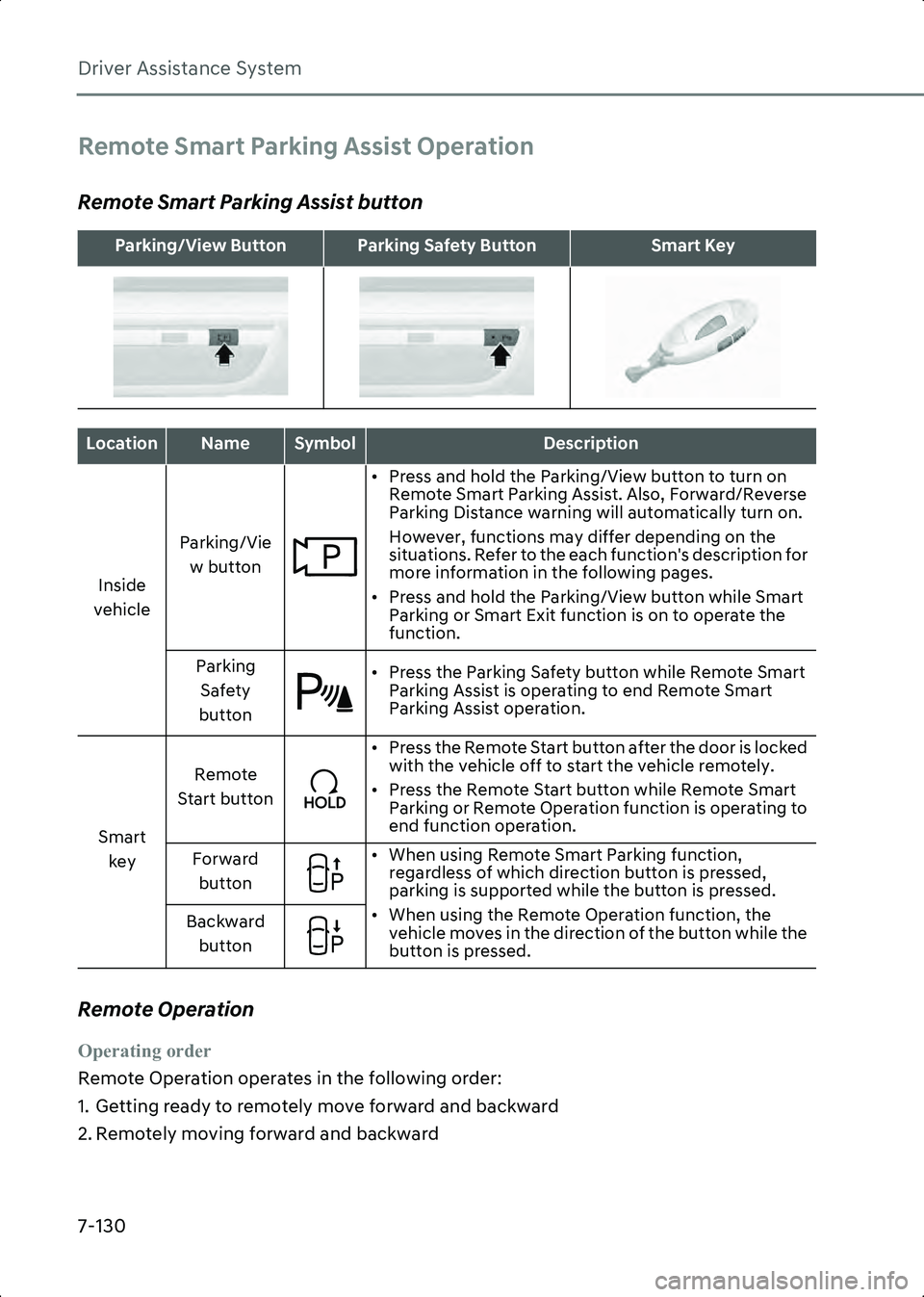
Driver Assistance System
7-130
Remote Smart Parking Assist Operation
Remote Smart Parking Assist button
Remote Operation
Operating order
Remote Operation operates in the following order:
1. Getting ready to remotely move forward and backward
2. Remotely moving forward and backward
Parking/View ButtonParking Safety ButtonSmart Key
LocationNameSymbolDescription
Inside
vehicle Parking/Vie
w button • Press and hold the Parking/View button to turn on
Remote Smart Parking Assist. Also, Forward/Reverse
Parking Distance warning will automatically turn on.
However, functions may differ depending on the
situations. Refer to the each function's description for
more information in the following pages.
• Press and hold the Parking/View button while Smart Parking or Smart Exit function is on to operate the
function.
Parking Safety
button • Press the Parking Safety button while Remote Smart
Parking Assist is operating to end Remote Smart
Parking Assist operation.
Smart key Remote
Start button • Press the Remote Start button after the door is locked
with the vehicle off to start the vehicle remotely.
• Press the Remote Start button while Remote Smart Parking or Remote Operation function is operating to
end function operation.
Forward button • When using Remote Smart Parking function,
regardless of which direction button is pressed,
parking is supported while the button is pressed.
• When using the Remote Operation function, the vehicle moves in the direction of the button while the
button is pressed.
Backward
button
Hyundai_CE_en_US.book Page 130
Page 476 of 582

Driver Assistance System
7-132
2. Remotely moving forward and
backward
B7008812
1. Press and hold one of the Forward ( ) or Backward ( ) button on the smart
key.
• Remote Smart Parking Assist will automatically control the steering
wheel, vehicle speed and gearshift.
The vehicle will move in the direction
of the button pressed.
• While Remote Operation function is operating, if the you let the button,
the vehicle will stop and function
control will pause. The function will
start operating again when the
button is pressed and held again.
2. Hold down the Forward ( ) or Backward ( ) button until the vehicle
reaches the target location.
3. When Remote Operation is done, get in the vehicle with the smart key or press
the Remote Start ( ) button on the
smart key from outside the vehicle.
• The message will appear on the infotainment system. The vehicle will
automatically shift to P (Park) and
engage the parking brake.
• When the Remote Start ( ) button is pressed, the vehicle will turn off. If
the driver is in the vehicle, the vehicle
will retain ON position.
Information • Remote Operation can control the vehicle remotely using the smart key outside the
vehicle.
• Check that all smart keys are outside the vehicle when using Remote Operation
function.
• Remote Operation function will operate only when the smart key is within 13 ft. (4
m) from the vehicle. If there is no vehicle
movement even when the Forward or
Backward button is pressed on the smart
key, check the distance to the vehicle and
press the button again.
• The detecting range of the smart key may vary depending on the surroundings that are
affected by radio waves such as
transmission tower, broadcast station, etc.
• When remotely moving forward using Method 1, it is recognized as an exit
situation, and the vehicle moves 13 ft. (4 m)
to check for parking lines, pedestrians,
animals or objects around the vehicle. After
confirmation, the steering wheel is
controlled according to the condition ahead.
• When remotely moving forward using Method 2, it is recognized as a parking
situation, and will immediately control the
steering wheel according to the condition
ahead to assist with entering the parking
space and aligning the vehicle. However,
performance may reduce depending on the
parking lines, pedestrians, animals, shape
of objects, location, etc., around the vehicle.
• For moving remotely backward, both Method 1 and 2 aligns the steering wheel
first, and then will only move the vehicle
straight.
WARNING • When using Remote Operation function, make sure that all passengers
have gotten out of the vehicle.
• If the vehicle’s battery is discharged or Remote Smart Parking Assist
Hyundai_CE_en_US.book Page 132
Page 477 of 582
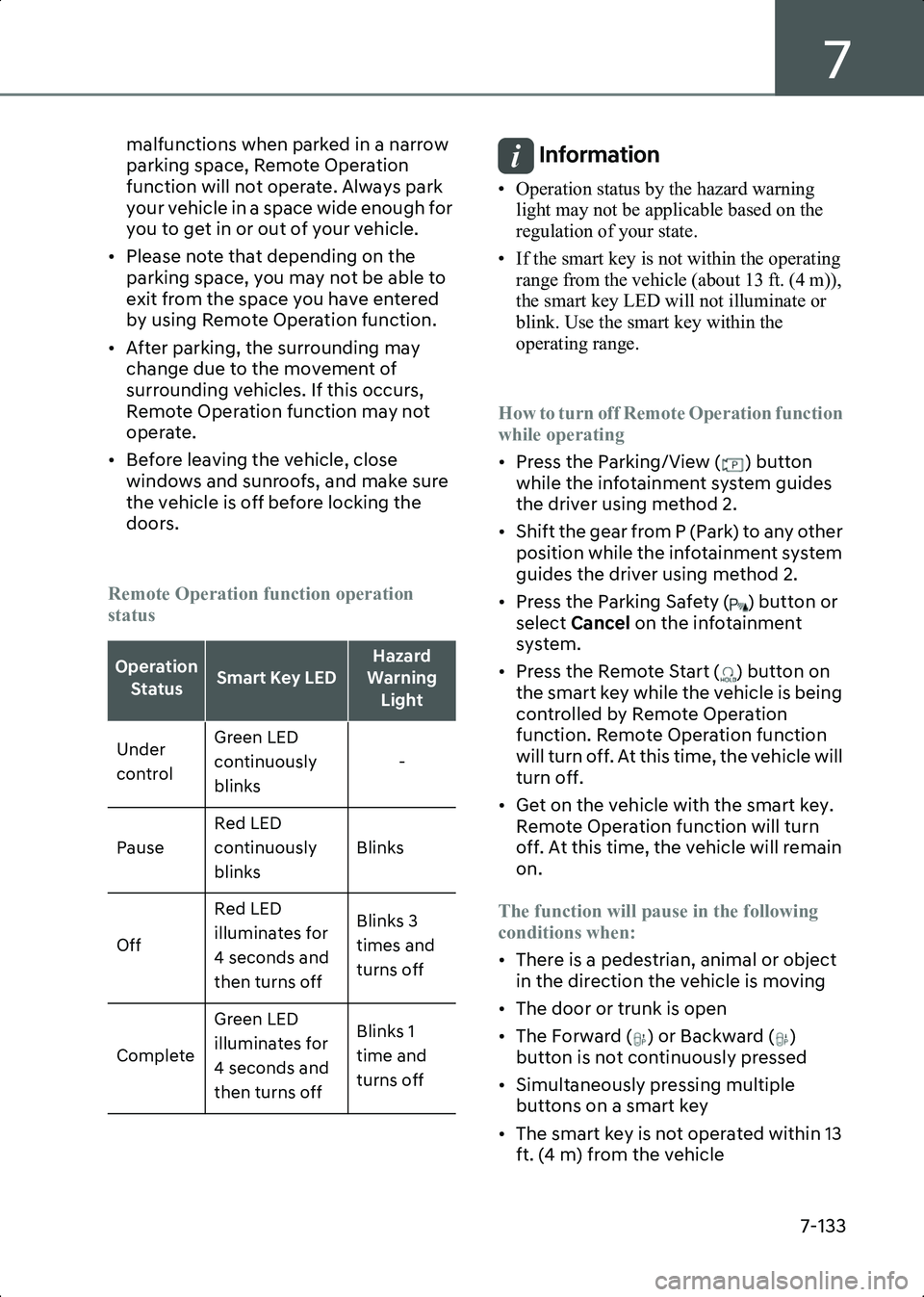
7
7-133
malfunctions when parked in a narrow
parking space, Remote Operation
function will not operate. Always park
your vehicle in a space wide enough for
you to get in or out of your vehicle.
• Please note that depending on the parking space, you may not be able to
exit from the space you have entered
by using Remote Operation function.
• After parking, the surrounding may change due to the movement of
surrounding vehicles. If this occurs,
Remote Operation function may not
operate.
• Before leaving the vehicle, close windows and sunroofs, and make sure
the vehicle is off before locking the
doors.
Remote Operation function operation
statusInformation • Operation status by the hazard warning light may not be applicable based on the
regulation of your state.
• If the smart key is not within the operating range from the vehicle (about 13 ft. (4 m)),
the smart key LED will not illuminate or
blink. Use the smart key within the
operating range.
How to turn off Remote Operation function
while operating
• Press the Parking/View ( ) button while the infotainment system guides
the driver using method 2.
• Shift the gear from P (Park) to any other position while the infotainment system
guides the driver using method 2.
• Press the Parking Safety ( ) button or select Cancel on the infotainment
system.
• Press the Remote Start ( ) button on the smart key while the vehicle is being
controlled by Remote Operation
function. Remote Operation function
will turn off. At this time, the vehicle will
turn off.
• Get on the vehicle with the smart key. Remote Operation function will turn
off. At this time, the vehicle will remain
on.
The function will pause in the following
conditions when:
• There is a pedestrian, animal or object in the direction the vehicle is moving
• The door or trunk is open
• The Forward ( ) or Backward ( ) button is not continuously pressed
• Simultaneously pressing multiple buttons on a smart key
• The smart key is not operated within 13 ft. (4 m) from the vehicle
Operation
StatusSmart Key LED
Hazard
Warning Light
Under
control Green LED
continuously
blinks
-
Pause Red LED
continuously
blinks Blinks
Off Red LED
illuminates for
4 seconds and
then turns off Blinks 3
times and
turns off
Complete Green LED
illuminates for
4 seconds and
then turns off Blinks 1
time and
turns off
Hyundai_CE_en_US.book Page 133